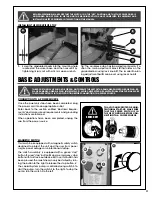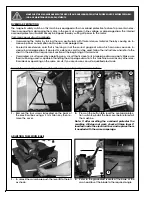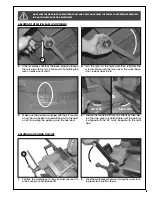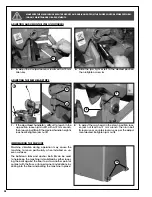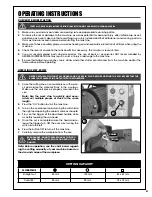
ELECTRICAL REQUIREMENTS
6
A
B
C
BEFORE CONNECTING THE MACHINE TO THE POWER SOURCE, VERIFY THAT THE VOLTAGE OF YOUR POWER
SUPPLY CORRESPONDS WITH THE VOLTAGE SPECIFIED ON THE MOTOR I.D. NAMEPLATE. A POWER SOURCE
WITH GREATER VOLTAGE THAN NEEDED CAN RESULT IN SERIOUS INJURY TO THE USER AS WELL AS DAMAGE
TO THE MACHINE. IF IN DOUBT, CONTACT A QUALIFIED ELECTRICIAN BEFORE CONNECTING TO THE POWER
SOURCE.
THIS TOOL IS FOR INDOOR USE ONLY. DO NOT EXPOSE TO RAIN OR USE IN WET OR DAMP LOCATIONS.
ELECTRICAL CONNECTIONS
Both a manual circuit breaker (or similar device) as well
as an electrical plug (similar to the one shown) are re-
commended and SHOULD BE INSTALLED BY A QUALIFIED
ELECTRICIAN.
Use locally approved wire
A
that includes a separate
grounding wire and a 3 prong grounding type plug
B
with a matching receptacle
C
.
GROUNDING INSTRUCTIONS
In the event of an electrical malfunction or short circuit, grounding reduces the risk of electric shock to the opera-
tor. The motor of the “M1” model of this machine is wired for 220 V single phase operation. As with many stationary
industrial type machines, because each installation situation is unique, this machine is supplied without a power
cord or plug. The installation of an appropriate power cord and plug must be performed by a qualified electrician.
The machine must be connected to an electrical source using a power cord that has a grounding wire, which
must also be properly connected to the grounding prong on the plug. The outlet must be properly installed and
grounded and all electrical connections must be made in accordance with all local codes and regulations.
CIRCUIT CAPACITY
Make sure that the wires in your circuit are capable of handling the amperage draw from your machine, as well as
any other machines that could be operating on the same circuit. If you are unsure, consult a qualified electrician.
If the circuit breaker trips or the fuse blows regularly, your machine may be operating on a circuit that is close to its
amperage draw capacity. However, if an unusual amperage draw does not exist and a power failure still occurs,
contact a qualified technician or our service department.
EXTENSION CORDS
The use of an extension cord is not generally recommended for 220 V equipment. If you find it necessary, use
only 3-wire extension cords that have 3-prong grounding plug and a matching 3-pole receptacle that accepts
the tool’s plug. Repair or replace a damaged extension cord or plug immediately. Make sure the cord rating is
suitable for the amperage listed on the motor I.D. plate. An undersized cord will cause a drop in line voltage result-
ing in loss of power and overheating. The accompanying chart shows the correct size extension cord to be used
based on cord length and motor I.D. plate amp rating. If in doubt, use the next heavier gauge.
TABLE - MINIMUM GAUGE FOR CORD
EXTENSION CORD LENGTH
AMPERES
50 feet
100 feet
200 feet
300 feet
< 5
18
16
16
14
6 to 10
18
16
14
12
10 to 12
16
16
14
12
12 to 16
14
12
*NR
*NR
*NR = Not Recommended

















